It’s possible that bagels are my favorite food. Yes, more so than tomato soup, than macaroni and cheese, even more so than chocolate chip cookie dough! And so I eat one almost everyday. It’s basically my lunch break and it’s a happy little time for me with my bagel, my black tea, and my Google Reader.
But here’s the thing – if I’m going to be eating a bagel every single day, I better make sure it’s healthy. For years, I made bagels with half white and half whole wheat flour, and I felt like that was a nice compromise between delicious and nutritious. Bagels with no white flour would be like hockey pucks, right? And they would taste like whole wheat. The horror!
I know I’m becoming a broken record, but the answer, of course, is in Peter Reinhart’s Whole Grain Breads. All it takes is a little overnight soak, and those whole grains act like refined white flour – they taste sweeter, form supple doughs, and bake into tender, light breads.
Not that it was smooth-sailing from the beginning with this bagel recipe. The problem I was having with this is that it’s too simple. Most bagel recipes need an overnight retardation in the refrigerator before they can be boiled and baked. This recipe doesn’t require that, and in fact, doesn’t need much time for a second rise at all. I’ve had the hardest time getting this through my stubborn head, and so over and over, I was making over-risen, sunken, ugly bagels.
A year after I started using this recipe, I think I’ve finally nailed it. You know what I did? I followed the recipe closer. My happy little bagel break just got a little happier.
One year ago: Pasta with No-Cook Tomato Sauce and Fresh Mozzarella
Two years ago: Country Egg Scramble
Printer Friendly Recipe
Whole Wheat Bagels (adapted from Peter Reinhart’s Whole Grain Breads)
Makes 8 large bagels or 12 small bagels
There are a few shortcuts in this compared to Reinhart’s original recipe. I make it every couple of weeks, so the faster I can get it done, the better!
I’ve played with the timing of this recipe quite a bit. The original results in fresh bagels 5-6 hours after you start (the second day). But I usually want them in the morning. You can refrigerate the dough in two places – either after the bagels are formed (in which case you should decrease the yeast slightly to prevent the bagels from over-rising) or right after kneading. The last time I refrigerated it after kneading, it rose overnight in the fridge, and in the morning, I immediately shaped the bagels and boiled them shortly afterward.
Pre-dough 1:
8 ounces whole wheat flour
¼ teaspoon instant yeast
6 ounces (¾ cup) water
Pre-dough 2:
2 tablespoons barley malt syrup
5 ounces water
8 ounces whole wheat flour
½ teaspoon salt
Final dough:
both pre-doughs
1 tablespoon water
2 teaspoons yeast
¾ teaspoon salt
7 tablespoons flour, plus more if necessary
1 tablespoon baking soda (for boiling)
1. In the bowl of a stand mixer fitted with the dough hook, mix all of the ingredients in Pre-dough 1 on medium-low speed until combined. Set aside for 5 minutes. Meanwhile, in a 1-cup measuring cup, stir together the barley malt syrup and the 5 ounces of water in Pre-dough 2. Set aside, stirring occasionally, until the barley malt syrup dissolves into the water. Return to Pre-dough 1 and knead on low speed for 1 minute. Transfer to a small bowl and cover with plastic wrap or a damp kitchen towel. Refrigerate overnight. Add the flour and salt for Pre-dough 2 to the empty mixer bowl; with the mixer on low speed, pour in the water-syrup mixture. Mix on medium-low just until combined. Cover the mixer bowl with plastic wrap or a damp kitchen towel and set aside at room temperature for at least 8 hours or overnight.
2. The following day, transfer the refrigerated Pre-dough 1 to room temperature for a couple hours to warm slightly. When you’re ready to make the final dough, stir together the 1 tablespoon water and the yeast. In the bowl of a stand mixer fitted with the dough hook, mix both pre-doughs, the water and yeast, and the salt on low speed until combined. While the mixer is running, add in the flour, 1 tablespoon at a time, until it’s fully absorbed by the dough. Knead on low speed for 5-6 minutes, adding more flour or water if necessary to form a smooth, firm dough. It shouldn’t be sticky.
3. Let the dough rise at room temperature until it increases to about 1½ times its original size, 1-2 hours.
4. Divide the dough into 8-12 pieces. Shape each piece into a smooth ball, then roll each piece into a rope about ¾-inch thick (slightly thicker for larger bagels). Bring the ends of the rope together and gently roll them on a flat surface to seal. Set aside for about 20 minutes.
5. Meanwhile, preheat the oven to 500 degrees, line a baking sheet with parchment paper or a silicone mat, and bring at least three inches of water to a boil in a large pot over high heat. Add 1 tablespoon baking soda, reduce the heat to medium-high and gently drop 2-4 bagels (as many as will fit without crowding) into the water. Boil for 1 minute, flipping the bagels halfway through.
6. Place the boiled bagels on the prepared baking sheet. Transfer the sheet to the oven, reduce the oven temperature to 450 degrees, and bake until the bagels are browned and feel hard, 13 minutes for small bagels and slightly longer for larger bagels. (The bagels will soften as they cool.) Cool completely before serving. (I can only fit one baking sheet, holding half a batch of bagels, in my oven at once, so I refrigerate the remaining unboiled bagels until the first pan is almost done baking, then boil and bake them.)
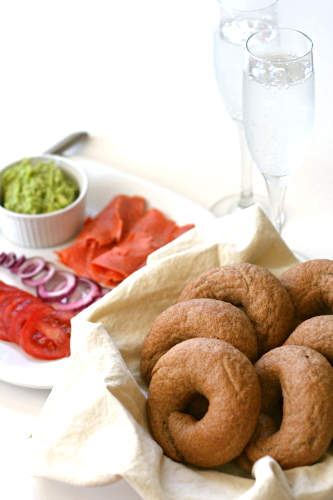

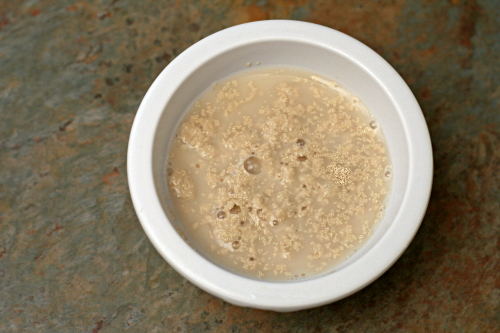
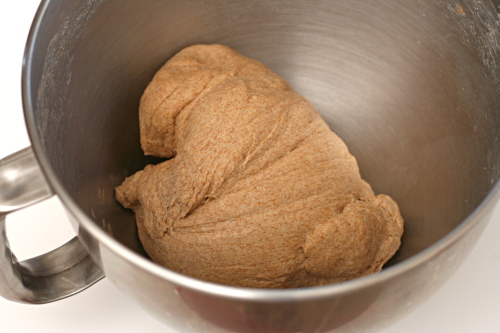
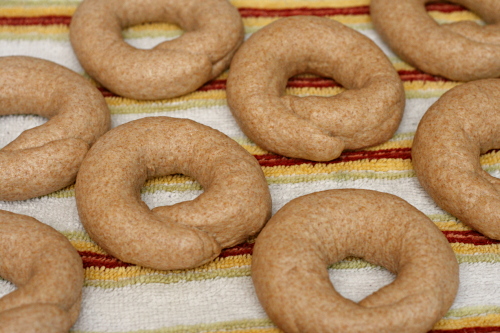

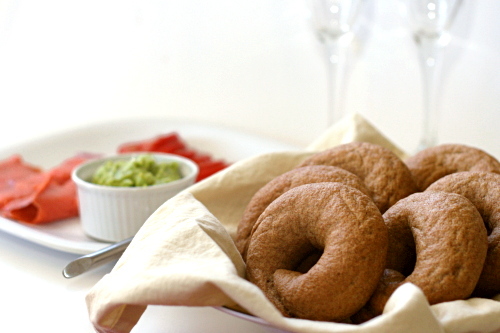






I have been craving bagels like nothing else lately, and you have them with my favorite toppings (minus the avocado). I need to try the whole wheat version!
I LOVE bagels too! I haven’t gotten up the nerve to try making my own yet though. Thanks for encouraging me!
you make it look so easy! i’d love to try this recipe.
Bagels are such comfort food- these look so good, and healthful too!
I wouldn’t have thought of making my own bagels, but these look terrific!
Ha this reminds me of when I made homemade bagels–they were NOT as pretty as yours! Yours are picture perfect and inspire me to try again 🙂
Your list of your favorite foods reminds me way too much of my own… Great minds think alike! :-p
This is such a great recipe! I usually double it and make 20 bagels and freeze them. They are also really good with “everything” toppings!
Did the bagels come out just as well when you let the dough rise in the fridge after kneading? How many hours did you approximately leave them in the fridge?
Sara – If I make the dough ahead of time, I usually leave it in the fridge for 10-12 hours. I’ve never noticed any difference in the outcome of the bagels.
Awesome, Bridget. Thanks for the feedback!
Thanks for linking to this again! I tried using Reinhart’s method to adapt my own bagel recipe to 100% whole wheat and promptly returned to a 50% whole wheat version. However, I gave them a try again yesterday, using your method, and they turned out fabulous! I think I prefer them to my white versions. Thanks!
Is there something you could substitute for the barley malt syrup?
Erin – I’ve used molasses, and that worked fine.
Hi 🙂 I know this post is from a while ago, but I thought I’d try my hand at asking a question. Did you ever have an issue with some of the bagels shriveling a little when they are placed in the boiling water? It appears as though a few from the first bagels that I put in the water shriveled more than the rest. They do look yummy though! It’s going to be really hard to wait till they’re cool to try them out!
Gianna – I think the shriveling might come from over-raising before the boiling step, but I’m not sure. You can see from the pictures here that mine were a bit shriveled, but it doesn’t happen to me anymore. It doesn’t seem to have a big effect on the outcome, but of course we want our food to look prettier, so I understand why it’s frustrating.